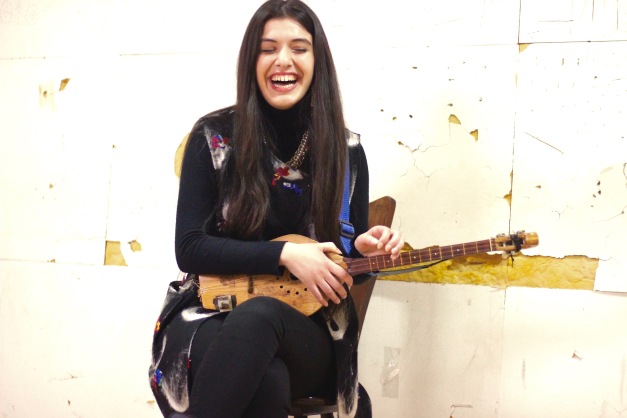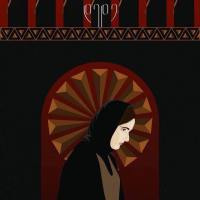Halfway Around the World for a Song
Note: Where are the puppets? See the note on Firebird Assoluta.
……………………………….

Mariam Elieshvili April 10th, 2016
Later the second week of my sojourn in Tbilisi I met up again with singer Mariam Elieshvili. This time I was treated by Mariam and her mother Ia to a Georgian meal of khachapuri, a covered sour cheese pizza without the sauce, and khinkali, a dumpling filled with meat, cheese, mushrooms or other stuffings, along with a goodly portion of savory juice. I shared a bit about my Alaskan life, complete with photos from Haines featuring bears, moose, mountains and puppets. In turn we discussed Georgian music and how Mariam had at the tender age of 18 already become something of a national celebrity with her own national folk music show. (For a sample follow this link.) Mariam also told me that she had arranged a meeting for the following Sunday with the band Chveneburebi, a word that translates into ‘our people’.

Mariam and her mother Ia.
When Sunday, April 10th, came I spent the morning visiting the Tsminda Sameba (Holy Trinity) Cathedral to hear music and to experience a Georgian Orthodox service. After a trek up a street passed more entropically weathered structures I found myself at the largest church in all of the Caucasus. I was familiar with many aspects of Orthodox Christianity but had never attended a church before. And when I did I experienced many new emotions. This is not the place to unfurl my thoughts in much detail but the music was indeed quite special as a quintet of girls punctuated the liturgy with a deeply beautiful polyphony. And as I watched the congregants come and go during the service I suddenly realized the reason why Georgia seemed to be organized on such different principles of social life compared to anything I had seen before. The difference between Eastern and Western Christianity was now tangible to me.

Inside Tsminda Sameba (Holy Trinity) Cathedral. The small cluster of women in the upper left corner are singing polyphonic Georgian Orthodox chants.
Later that day I met up with Mariam and Ia again at Marjanishvili Square. We took the metro to the old Griboedov Theatre building. It was on the border of a recent demolition site where a new edifice would soon be occupying the hollowed out lot. After clearing security we traveled to the top floor and a found ourselves in an old recording studio with the members of the male folk singing group Chveneburebi. Again here were men you wouldn’t have noted if you’d seen them on the street or on a construction site. They strummed on the panduri, a three stringed instrument with plastic or gut strings, and it’s slightly larger bass relative, the chonguri, as well accompanying themselves with frame drum and accordion. And they waited for me to let me hear their lively version of Georgian folk music.

Jege with Drum and Giorgi on Accordion
Again moving quickly, musicians are always ready before the camera is, I was introduced by Mariam to Giorgi Gobejishvili, Jege Sakhokia and the other members of the group. They practiced a few tunes as I figured out the best set up in the cramped studio space. When Chveneburebi perform they usually dress up in traditional costumes with a show that includes singing, instrumental music and even a bit of dancing. Finally everything seemed in order. Mariam and Ia sat back in the corner as I tried to adjust the sound. And then they began to sing.
This music was quite different from what I had experienced at Giorgi Ushikishvili’s National Folklore School. And I was fast coming to realize that styles in Georgian depend greatly on where the music originates from. There isn’t one Georgian style. There are many styles depending on which part of the country it originates from. Compared to the mysterious style I’d heard earlier Chveneburebi played a stronger earthier style. (No doubt they knew many of the other songs as well.) They asked me what I wanted to hear. And I regretted not being familiar enough with Georgian songs yet to name many. But I did manage to remember Rachuli! They sang with a strong collective voice that then diverged into repetitious patterns that were sped up by hand claps and a strong shouts. Obviously many of these songs had been work songs. Not only that they also knew the yodeling technique unique to Georgia as well. Sometimes they would put their hands on each others arms and move in circles. I could only imagine this music in its element back in the mountains.
And one thing I have come to realize over time is that Georgians not only have a strong sense of melody, a powerful propulsion of rhythm and a deeply moving harmonies, but perhaps above all they possess an unerring dynamic structure to most of the music they perform. They know when to add new elements to the song that they excel in above all. Chveneburebi was no exception. Neither was Mariam Elieshvili. When Mariam performed her classic song Chven Exla Erturts, she effortlessly modulates up a key halfway through the song. I think the idea of a simple verse chorus verse chorus pattern without dynamic escalation would never occur to the Georgians. When America had a folk revival in the 1950s and 60s most performers simply played the songs. Much American pop music merely follows the song with instrumental breaks. Nice arrangements, yes. But I have heard recordings of Georgian music that simply left me gasping for joy at the development of the tunes.
Eventually Mariam joined Chveneburebi for a quieter more introspective song and then I got her to sing three songs by herself: Lale, that starts as a haunting slow plaintiff song, Chven Exla Erturts, which she had composed around a poem with the help of her school mates and had already been adopted as a classic Georgian tune played by many others, and Shenma Survilma Damlia, another deep folk song. (The first two of which I did ask for specifically.) I had wanted to film her simply singing, without all of the jitteriness of the usual home video or cellphone video. Or without the backdrop of a Georgian television stage.
Mariam Elieshvili’s type of music is certainly folk music by American standards, but it is a newer form of folk music by Georgia’s much stricter standards. Whereas Georgian folk music is seen as having no author, simply being passed on. What Mariam does can include those older songs, which she certainly knows, but it can include more recently written songs and tunes in Georgian style. This music is often passed on through YouTube videos, especially since Georgia’s music industry has a great deal of difficulty in policing its recordings. I view it as a highly healthy musical development, as opposed to merely imitating American or Western European styles. The shared videos are themselves a form of folk sharing in the digital age.
And in a way hearing Mariam sing in person had been one of the goals of this whole journey. I had originally discovered her YouTube videos back in early 2012. In the first video I discovered she was sitting in an unpretentious room with her brother Sandro. She sang and he was playing a panduri while singing harmony. The song was called Ayvavebula. I had looked and thought okay here are a couple of kids singing, she was 13 or 14 then, her brother younger, but as soon as she opened her mouth I knew I was in a different musical universe. And that led me to make hundreds more discoveries in Georgian music. And so sitting here now listening to her sing in my presence, especially considering the success she has had since then, was a profoundly privileged moment. I thought how I had bridged the vast gulf between my virtual introduction to a singer and a land almost exactly halfway around the world to the reality of hearing such a pure voice sing in my own presence in a small studio in Tbilisi Georgia. I could rest easy after that.

Mariam after a song.
And not only that I had made a new friend in Mariam, or should I say several friends. I bid the men of Chveneburebi adieu. And I said very fond farewells to Mariam and Ia. I knew I would meet them again someday.






Byrne, your words describe my sentiments as precisely as a stenogram!! My feelings were identical to yours, when discovering Mariam and Sandro, also in 2012 on Facebook. I knew immediately that this was a talent of the likes of Nana Mouskhouri, Joan Bayez, Esther Ofarim to name just a few of the better known ones. She is already a legend, due to her voice, her grace, her ethereal beauty and her charm. She is also an exceptionally graceful and gifted dancer, dancing apart from the diverse Caucasian dances also Spanish Flamenco, etc. virtuously. She sings in several languages, Georgian, Mngrelian, Ivrit and Lazuri. Soon in English, I could imagine, considering her excellent command of the language. I am so glad that YOU did actually manage to bring yourself to Georgia and meet and cooperate with these lovely folks. CHVENEBUREBI are good personal friends of mine, as we met in Germany twice already and kept close contact through facebook. Wonderful guys! I hope you had a chance to listen to their interpretation of CHAKRULO, performed in 2008 during a tour through the Baltics, coinciding with the terribly unfortunate Russian military attack on Georgia , provoked by imbalanced politics of the time. If not, here is the LINK: https://www.youtube.com/watch?v=tDdWFewtfzY
Good to see you around and learn about your experiences in Georgia!! BE GOOD!
May 28, 2016 at 11:11 AM
Thanks Tino. I appreciate the encouragement. And I in my way am doing what I can to expose the world to the amazing sounds of Georgia. I am currently beginning work on a documentary, while waiting for the rest of the Gravity From Above funding to come through, about the incredible music and dance of Georgia. And that documentary will indeed feature Mariam, Chveneburebi, Sukhishvili and many more. Now I just need to start raising the funds! I know that they will come. Thanks again for your kind words.
May 28, 2016 at 11:26 AM